Scholarship as Conversation
by Professor Lisa Lucas Hurst
What does the term “Scholarship as Conversation[1]” mean, and why is it important?
Note to instructors:
- To engage more students, videos are linked throughout this explanation. Screen shots and transcripts of the videos are included at the end.
- Possible class activities are included at the end.
What do you mean by “scholarship?”
You’ve probably heard the word “scholarship” in a specific way—as in winning a scholarship for college. I am using the term differently here, in a way that is more specific to academia. You’ve probably heard the term “scholar:” someone who studies a topic enough to develop expertise in that area. When scholars share their ideas with other scholars—whether by writing an essay and submitting it to a journal or by giving a presentation at a professional conference—they are contributing to the scholarship in that discipline. Professors, in fact, are expected to contribute to scholarship in their area of expertise.
Okay, so what is the “conversation”?
Most of us have conversations every day, but within the context of “scholarship as conversation,” I am referring to the scholarly conversation around a specific topic. In academic settings, when professors refer to scholarship, they are usually referring to the traditional, more formal scholarly conversations, such as what you would find in academic journals or at academic conferences.
With the development of the Internet and social media, however, people have numerous outlets for sharing their ideas, which is often referred to as “entering the conversation.” In his TED talk “How social media can change history,” scholar Clay Shirky claims that the development of the Internet/social media has resulted in the “largest increase in expressive capability in human history.” That means that the “conversation” is now much larger, with many more voices than ever before. This is an amazing development, but how do we discern which conversations are more “scholarly?”
As a student, and as a critical thinker navigating the world of information, it benefits you to understand the different “places” where you can find these conversations. Some venues are more formal, such as journals and conferences intended for academics, researchers, and professionals, while magazines, blogs, vlogs, and video tutorials are much less formal venues. As you increase your information literacy, you will grow your skill in determining which venues and voices are the most credible. For academic settings, your professors will most likely want you to stick with sources found in library databases.
_____
[1] The concept of Scholarship as Conversation is key to growing your information literacy skills, and it is part of the Association of College and Research Librarians Information Literacy Framework: http://www.ala.org/acrl/standards/ilframework - conversation.
_____
Here are 2 videos that give an overview of “Scholarship as Conversation.” (Transcripts included below.)
Click here for a 2-minute video from the University of Washington Libraries.
Click here for a 3-minute video from the West Virginia University Libraries.
What are some examples of scholarly conversations?
There are scholarly conversations about whether it’s better for students to take notes by hand or with a laptop, why our climate is changing, and the impacts of social media on depression and anxiety. If you know where to look, you can find scholarly conversations about almost any topic.
Where did this idea come from?
It was the scholar Kenneth Burke who developed the idea of scholarship as conversation in the passage below, often referred to as the Burkean Parlor Model. (Parlor is an old-fashioned word that refers to a room in a house set aside for entertaining visitors, but it can also mean a public space for deep conversations.)
Here is Burke’s famous passage:
Imagine that you enter a parlor. You come late. When you arrive, others have long preceded you, and they are engaged in a heated discussion, a discussion too heated for them to pause and tell you exactly what it is about. In fact, the discussion had already begun long before any of them got there so that no one present is qualified to retrace for you all the steps that had gone before. You listen for a while until you decide that you have caught the tenor of the argument; then you put in your oar. Someone answers; you answer him; another comes to your defense; another aligns himself against you, to either the embarrassment or gratification of your opponent, depending upon the quality of your ally's assistance. However, the discussion is interminable. The hour grows late, you must depart. And you do depart, with the discussion still vigorously in progress.
(Kenneth Burke, The Philosophy of Literary Form: Studies in Symbolic Action 3rd ed. 1941. Univ. of California Press, 1973)
Burke is using the metaphor of a parlor brimming with people deep in conversation to describe the scholarly conversation and the process of joining or entering that conversation. The process is similar to what you will face as a student researcher: the conversation about your topic has been going on long before you even knew about the topic, so listening before jumping into the conversation is critical. Others in the conversations may agree or disagree with what you have to contribute or with parts of your argument, but regardless, the larger conversation will go on long after you leave it.
Click here for a 3-minute video from the Eberly Writing Center that explains the Burkean Parlor Metaphor and how it applies to academic writing. (Transcript included below.)
So is the conversation about addressing the “other side?”
In everyday life, you may find that issues are presented (whether by the news media or at the local eatery) as if there are only two sides. If you have been fortunate enough to write an argumentative paper or take a class in argumentation, you may have been taught to address the “other side.” While this advice has some merit, it presents issues as a simple binary where there are only two “sides.” Life is rarely, if ever, that simple.
Scholarly conversations are more wide-ranging and unwieldy than a simple binary, and they never end: that’s why in the passage above, Burke described the scholarly conversation as “interminable” (which roughly translates as “without termination”). For example, initial studies evaluating using a laptop to takes notes during a lecture concluded than using laptops led to worse test scores because students got distracted by other tasks on their computers during class. Other studies concluded that taking notes by hand rather than with a laptop leads to better comprehension because laptop notetaking led to verbatim transcription rather than deep processing of the concepts presented. Still other studies added nuance to the conversation by pointing out that laptop notetaking leads to more volume of notes, which can lead to better comprehension as long as students know how to study those notes effectively. As you can see, to present this issue as laptop vs. long hand is reductive: there is a great deal of nuance in that conversation!
As you’re becoming more familiar with the concept of Scholarship as Conversation, can you see how the “two sides” model of thinking does not fully capture any issue/conversation? Filmmaker Albert Maysles once said that “tyranny is the deliberate removal of nuance.” While tyranny seems a strong word for the loss of nuance in conversations, consider the ways that voices are shut out of conversations in order to present issues as having only two clear sides. While some people may tend to be “black or white” thinkers, almost any scholarly conversation has shades of gray. Be wary information venues that present only the black and white “sides” while excluding the shades of gray. Seek out the nuances of the conversation.
Click here for a 1-minute video from the Steely Library at Northern Kentucky University that highlights the need for understanding multiple perspectives. (Transcript below.)
Click here for a 3-minute video from the Oklahoma State Library. (Transcript below.)
How does what I already know about a topic affect my research?
Prior learning about a topic is not a bad thing. However, if you’ve already come to a conclusion, you face a challenge. Scholars in the field of psychology have shown that if your mind is already made up, you are not likely to absorb information that runs counter to what you’ve concluded: This is called confirmation bias, and there’s a huge scholarly conversation around this concept. More than 100 years before this research was ever conducted, philosopher John Stuart Mill explained the importance of listening to other perspectives with the presumption that they are authentically coming from a place of honest inquiry (unlike how political opponents today vilify each other without listening):
He who knows only his own side of the case knows little of that. His reasons may be good, and no one may have been able to refute them. But if he is equally unable to refute the reasons on the opposite side, if he does not so much as know what they are, he has no ground for preferring either opinion. . . Nor is it enough that he should hear the opinions of adversaries from his own teachers, presented as they state them, and accompanied by what they offer as refutations. He must be able to hear them from persons who actually believe them. . . he must know them in their most plausible and persuasive form.
(John Stuart Mill, On Liberty, 1859; bold emphasis mine)
Yes, this quotation harkens back to the “opposing sides” type of thinking, but I included it to demonstrate the importance of withholding judgement about a source until you are familiar with the larger conversation. It is not enough to quickly take in a few opinions across the conversation that disagree with your own: you must earnestly consider them, and you must attempt to hear these opinions in their best possible form from the best possible sources rather than mentally dismiss them because you already hold a different opinion. In other words, it’s important to approach all voices in the conversation with an acknowledgement of your own bias.
This fundamental disposition should be a life-long habit in your quest to understand scholarly conversations within the larger information landscape. In fact, this disposition is another part of the Association of College and Research Librarians Information Literacy Frameworks: “Learners who are developing their information literate abilities develop awareness of the importance of assessing content with a skeptical stance and with a self-awareness of their own biases and worldview.”[1]
Click here for a 3-minute video from Gumberg Library/Duquesne University about confirmation bias.
Click here for part 2, another 3-minute video from Gumberg Library.
Will I be expected to add to the conversation?
Being a non-expert doesn’t mean that you have nothing to add to the conversation. After all, you have the ability to think critically and form your own opinion. John Taylor Gotto, the well-known public-school teacher, said that brilliance is “common as dirt.[2]” If you have an insight that you’re not seeing in the conversation, consider joining the conversation to share your little bit of brilliance. As you progress in life and continue to develop your expertise, you will have more and more to share with the world.
Click here for a 1-minute video from Clemson Universities on “Joining the Scholarly Conversation.” (Transcript below.)
Click here for a 2:45 minute video from Texas State University Libraries about how you can enter the conversation. (Transcript below.)
Scholarship as Conversation videos:
Why am I including multiple videos? They are all on the same topic, but each explains the concept a little differently. We get a much better picture by watching and considering all these viewpoints instead of just watching one. We also benefit by understanding what all the videos agree on, and then by considering what each adds to that. Can you see that this process encapsulates the idea of “scholarship as conversation?” Within any conversation, some basic tenets will be generally agreed upon, but each voice in the conversation can add something that the others don’t mention. You can ask yourself these questions any time you are examining a conversation:
- What is the common ground?
- Where is there disagreement?
- What voices are left out of this conversation?
As for these particular videos, you may want to add the following questions for class discussion or self-reflection:
- How is Burke’s Parlor model explained in the videos? Is that a fair representation of Burke’s metaphor? Why or why not?
Suggested activity for in-class or online discussion of Scholarship as Conversation videos:
- Watch each video & take quick bullet-point notes (NOT full sentences). After each video, make a bullet-point list in which you restate the main points of the video in your own words.
- Using the bullet-pointed responses, write 2 paragraphs for the Discussion Board OR for in-class discussion:
- Paragraph 1: Explain your understanding of "scholarship as conversation" as a metaphor for reading, writing, and research in academic settings. Does the metaphor make sense to you? Do you see how it fits this class?
- Paragraph 2: What questions are you left with? If the metaphor still doesn't make sense to you, please help us to understand what doesn't make sense.
- Read/Listen to your classmates' 2 paragraphs & try to learn something more.
- Do they have the same understanding as you? (Add to your notes when you learn something!)
- Do they have the same questions as you?
- If you sense that a classmate is struggling to understand, try to help them. (This is what learning communities do!)
______
[2] https://www.ala.org/acrl/standards/ilframework - authority The quotation is part of the learner dispositions for the frame “Authority is Constructed and Contextual.”
[3] From Dumbing Us Down: The Hidden History of Compulsory Schooling. New Society Publishers, 25th Anniversary edition, 2017.
_____
Video Links and transcripts included below.
Please note that any bolded emphasis is mine.
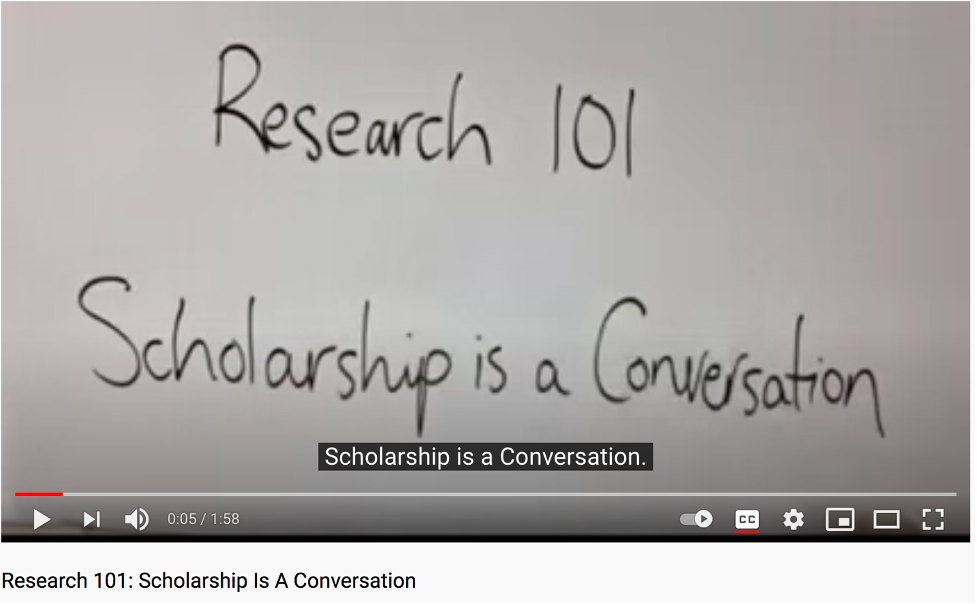
Video link: Research 101: Scholarship is a Conversation
University of Washington Libraries
Transcript:
Published articles & dissertations form a discussion that involves critiques, arguments, and additions to our understanding of the world.
But, wait! What does that mean?
Well, you know when you're at a party and there are a lot of different conversations going on at once? In one corner, people might be discussing climate change and pollution. On the other side of the room some people are talking about the new electric car technology. You have heard both of these conversations and begin a new conversation that discusses the impact of technology in reducing pollution.
This is what the scholarly conversation is: It’s multiple people writing & publishing their ideas and hoping that others will pick up and use this information to form new conversations.
Now, this party is really huge. There are a lot of conversations happening at once and not everyone agrees. In all of these situations, you're just hearing a part of the story from a few voices. Any given piece of scholarly work does not represent the only, or even the majority, perspective on the issue at hand. A single source represents just the view and research of that author. Additionally, you're entering the middle of the conversation, certainly not the end.
When you are conducting research as a student, it isn't possible to read every article on a certain topic. However, you should read some articles to get a sense of the context for the research related to your topic. As you research, it's necessary to evaluate the work of others, but also try to see yourself as a producer and a consumer of information. As a student, you can contribute to the scholarly conversation.
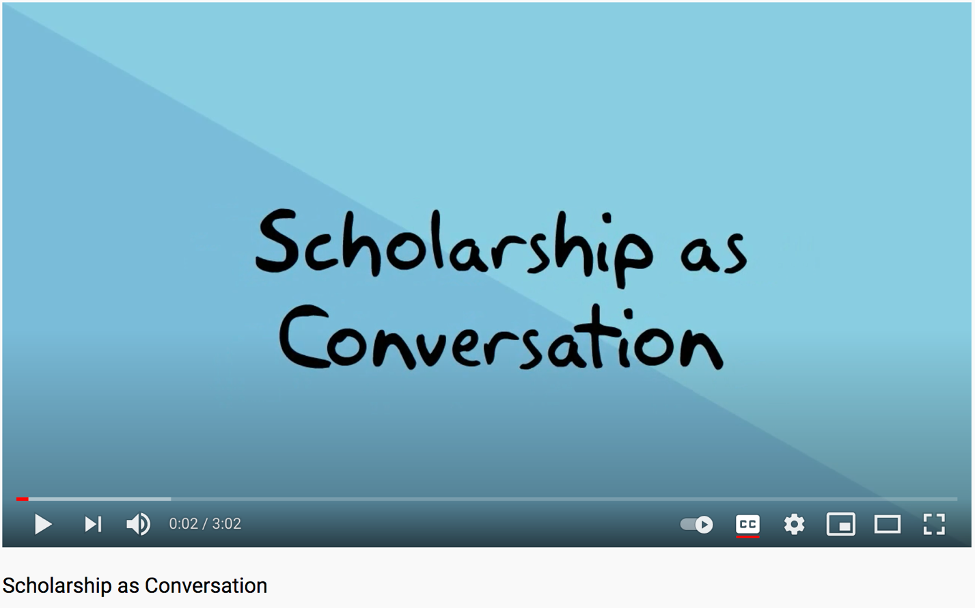
Video link: Scholarship as Conversation
West Virginia University Libraries
Transcript:
Now that you're in college you'll be asked to write a lot of research papers and you'll be asked to cite a lot of information sources in those papers but why a research paper? What's the purpose and how might they differ from the papers that you wrote in high school?
On a daily basis you look for information on the web. It's usually factual to answer pretty simple questions like where's the closest pizza place or what time does the show start tonight. In high school, you may have written papers but often these were really reports that summarize the ideas of others: you may have used five sources maybe from the web and simply mash them together to create your paper.
In college, you'll be expected to ask more meaningful questions that don't always have one definitive answer. Your professors want you to look at the topic from multiple angles and come up with your own thoughts or opinions. In college, we hope you realize that the research process is like a conversation rather than looking up facts.
You'll be asked to join the scholarly conversation about a topic. First you'll need to do some reading about your topic to listen in on the conversation that's already happening: What are the main issues and perspectives? Who are the major players talking and writing about them?
Then you should jump in and join the conversation and add your own thoughts. This is the purpose of the argumentative research paper. Of course, you still need to cite quality information sources in your paper to back up your argument. Read beyond the headlines and get to the good stuff so you can really understand the complexity of an issue. Be a scholar in training: ask interesting questions read and revise your questions and then don't be afraid to create new knowledge.
Remember the library is here to help you throughout the process!
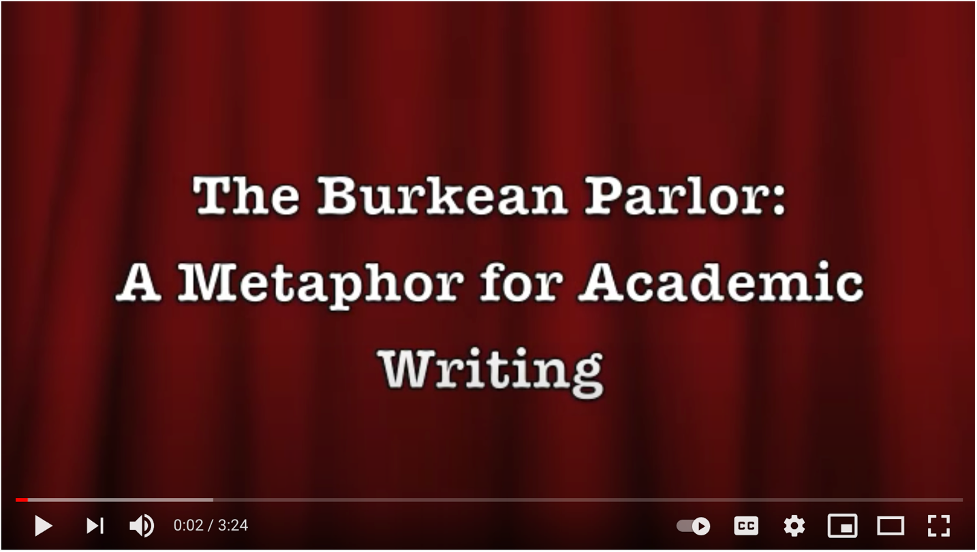
Click here for a 3-minute video from the Eberly Writing Center that explains the Burkean Parlor Metaphor and how it applies to academic writing.
Imagine that you enter a parlor. You come late. When you arrive, others have long preceded you and they are engaged in a heated discussion, a discussion too heated for them to pause and tell you exactly what it is about. In fact, the discussion had already begun long before any of them got there so that no one present is qualified to retrace for you all the steps that had gone before. You listen for a while until you decide that you have caught the tenor of the argument. Then you put in your oar. Someone answers. You answer him. Another comes to her defense. Another aligns himself against you, to either the embarrassment or gratification of your opponent depending upon the quality of your ally’s assistance. However, the discussion is interminable. The hour grows late. You must depart and you do depart with the discussion still vigorously in progress.
What you just heard is called the Burkean parlor metaphor. In order to understand it, it’s important to know what a metaphor is. According to the Oxford English Dictionary, a metaphor is something regarded as representative or suggestive of something else. The Burkean parlor works as a metaphor for academic writing, especially in the Norman Emmy Burley Writing Center. The opening scene of the Burkean parlor acts as a metaphor for a writer's entrance into an academic discussion. Like in the Burkean parlor, the writer may find herself joining into a literary discussion without previous knowledge, just as a student may enter the Writing Center with a prompt and no specific background information. In the Burkean parlor metaphor, the participants are unable to explain where the discussion began, just as it is important for the writer to remember that her paper is in addition to a long chain of discussion, just as in the real world a writer's paper responds to a pre-existing literary dialogue.
In the Writing Center, a writer is not expected to know everything about her subject nor is she expected to be a perfect writer. As in the Burkean parlor, she will have to familiarize herself with the discussion surrounding her topic. It is important to know the opinions that have been expressed previously on the issue in order to form a unique opinion. Once the writer is sufficiently familiar with the discussion, she can freely join in sharing her own view through the lens of her paper. When writing a paper, the writer need not respond to every opinion she has encountered—only the ones she finds the most thought-provoking. The Writing Center provides an atmosphere of collaboration to aid students in focusing their ideas so that ultimately, a writer is contributing to but not putting it into the argument. Writing Center tutors focus on the writing process and the writers themselves instead of the finished product. The Writing Center, then, becomes a Burkean parlor for all students!

Video Link: https://www.youtube.com/watch?v=VILSLTnfKKs
Steely Library at Northern Kentucky University
Transcript:
For his history class, DeSean has to write a research paper on the causes of World War II.
He bases most of his argument on a single book.
After reading the rough draft, his professor tells him that before he relies so much on this one book he needs to look at other books and articles on the topic. As he does so, DeSean realizes that most other historians actually disagree with the conclusions made by the author of the first book. He even finds some articles where other historians specifically point out the problems they see with the book he was using. In this situation, DeSean is coming to understand the concept of Scholarship as Conversation.
At first he did not understand that the book he found was not the final word on the topic. But as he read the additional books and articles, he came to see that his book was part of an ongoing debate that historians have been having on the topic, and that it represented only one perspective. He was surprised to realize that historians do not always agree. Instead, for many topics, there is not one clear answer that everyone accepts. As he comes to understand the idea of the "scholarly conversation," DeSean realizes that he cannot determine the value of any particular information source until he understands the broader conversation that is taking place around that source.
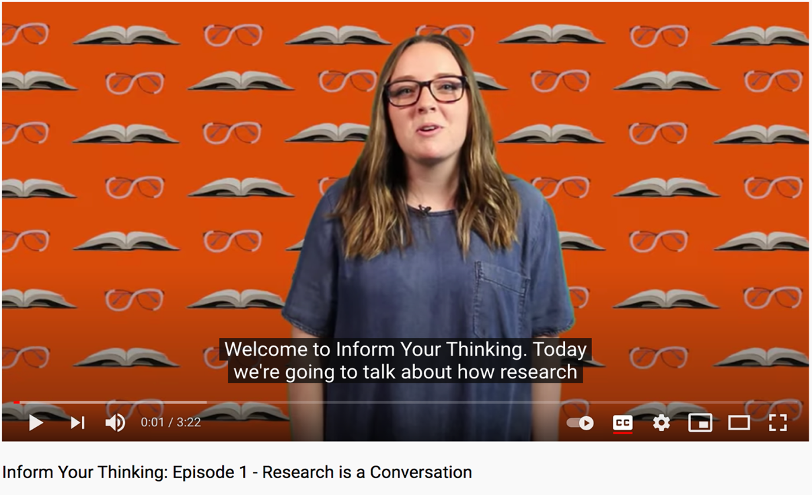
Video link: Inform Your Thinking: Episode 1—Research is a Conversation
Oklahoma State Library
Transcript:
Welcome to Inform Your Thinking! Today we're going to talk about how research is a conversation. Let's get started.
All of us have to do research for our classes. Comp 2, physics, history—we're doing research all the time. Coming up with topics, finding sources, asking questions and doing experiments—it can be really tough. But you're not alone when you're researching. Scholarly research is the product of many different voices, potentially including your own, coming from many different places. Academic research is a back-and-forth conversation between many diverse voices leading to a generation of new ideas.
Just like any conversation, it's easy to get involved and contribute. Here are some quick tips on how you can become a part of [the] academic conversation going on in your major and areas of interest. When you're in a conversation, it's important to know who you're interacting with. When doing research, you should learn more about the sources you're using and who created them, what the authors have to say about the topic & why you should trust them. Try Googling them to see what else they've written and what kind of academic experience they've had. Are they recognized as an expert?
And remember that your sources are just parts of a larger conversation that you've stepped into. Take a look at the citations in your sources and you can find many others who are already a part of the ongoing dialogue. Track down their research too! Figure out who else is in the conversation and discover what they have to say.
When you join a conversation, it helps to know something about the topic so you don't butt in with something irrelevant or blurt out something awkward. Make sure you do some investigation online and through the library's resources to build a better understanding. You can get a feel for the issues being addressed and the questions being asked about your topic. Then you can jump in with an educated comment and be ready to learn more.
Your professors have a lot of experience being a part of academic conversation. Students may not feel that they have much to contribute to this conversation but you do! Keep researching and talking to those who are already a part of the conversation. The more information you learn the better prepared you'll be to enter into academic dialogue. As a college student you're surrounded by professors and experts who have already contributed to that academic conversation.
You can contribute something too, but remember not everyone has access to or an equal say in these conversations. Some voices are louder and more privileged than others and make it difficult for others to be heard. What can you do to make sure that these voices including your own are recognized and heard? Always remember their conversations happening in all different kinds of places. Blogs, newspapers, academic journals and conferences. Get all the information to get the big picture. There is never only one point of view in a conversation. There are competing voices and perspectives and the conversation is ongoing and never-ending.
Remember you have a role to play in making discoveries and advancing academic research. Get involved and be a part of the conversation.
And that's how you inform your thinking!
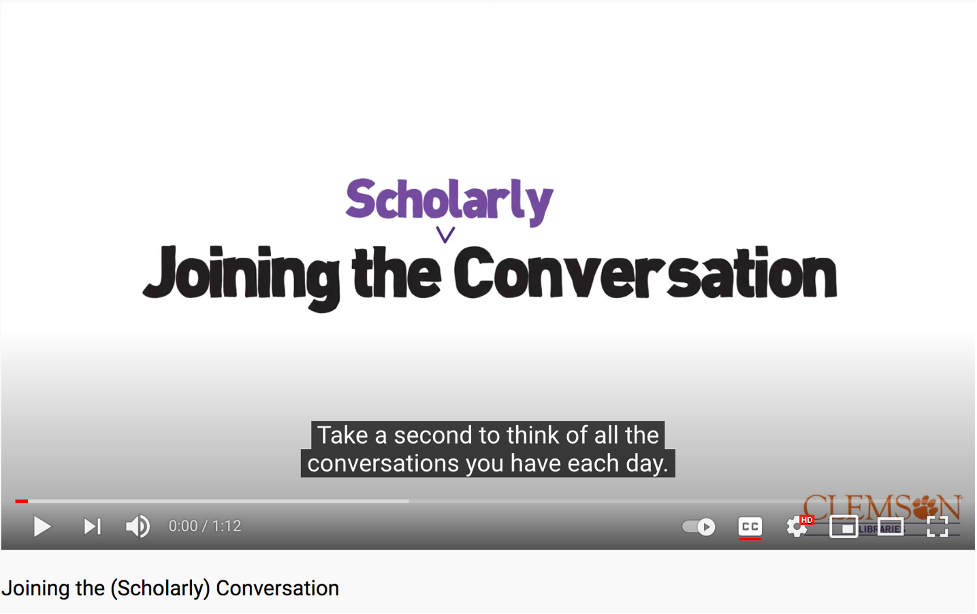
Video link: Joining the (Scholarly) Conversation
Clemson Universities
Transcript:
Take a second to think of all the conversations you have each day. They probably happen all over the place! You're constantly exchanging ideas and evaluating new pieces of information.
Doing academic research is a lot like having a conversation with experts on your topic. You can also think about it like going to a party—a big party, the kind of started long before you got there and will keep going long after you leave.
You could just show up and start talking, but conversations are complicated! You have to listen a while to figure out what people are saying. Once you have a sense of what's going on, then you can join the conversation. With research, listening can mean reading, watching, discussing—any way you interact with information. Joining the conversation could be writing a paper, making a video, and even posting on social media or talking to your classmate.
Don't just show up and say things. Learn about the part of the conversation that's already happened and try to see it from multiple perspectives. You'll also start to notice when voices have been left out of conversations. Part of your job as a college researcher is to recognize what's missing.
Not sure how to catch up on a scholarly conversation and evaluate all the perspectives? Ask a librarian!
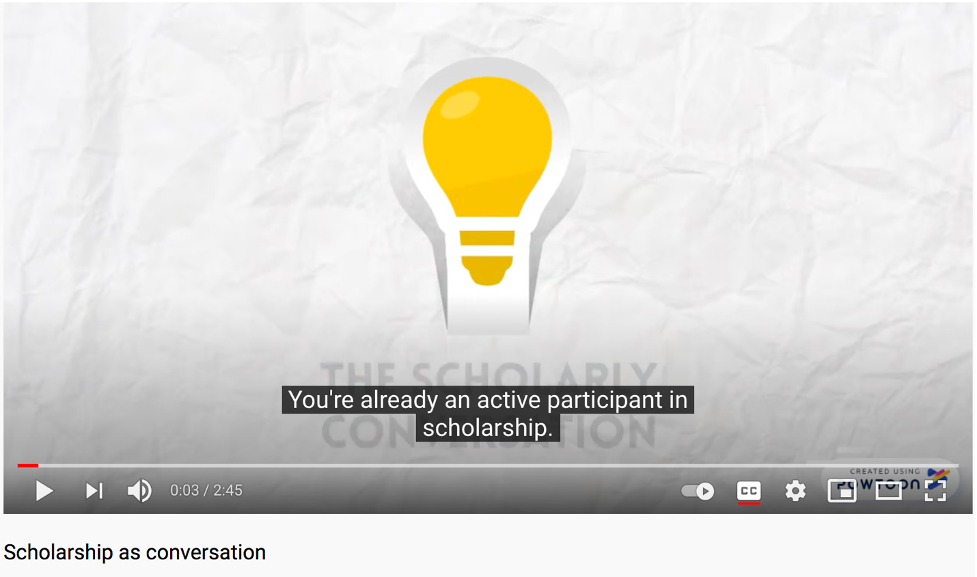
Video link: Scholarship as Conversation
Texas State University Libraries
Transcript:
You're already an active participant in scholarship. You attend lectures, read articles, cite literature, write reviews, and participate in discussions. You are not just a consumer of information, you’re a participant in a conversation. Who else is in on the conversation?
Scholars, researchers, and professionals join the conversation in a formal manner. They write articles, publish research, or implement solutions to problems in the real world. The conversation also continues in an infinite variety of informal venues: from conferences to classes, social media to the water cooler, people are engaging in conversation about scholarship everywhere.
As a student, you’re developing your scholarly voice in all the conversations you join. When you write a research paper, prepare a poster, or give a presentation you are engaging with the material in a critical and more formal way. You are critically evaluating, citing, and contributing to conversations on all the issues and topics of your discipline. At this point in your academic career, gone are the days of simply summarizing articles.
You are developing your voice, interpreting, applying, and even creating new knowledge in the work you produce. By citing your sources, you acknowledge those academics with whom you are conversing, but it doesn’t have to end there. Publishing your work allows your thread of the conversation to continue.
